Analysis of Leadership and Management in M&S Operations
VerifiedAdded on 2020/12/29
|15
|4305
|88
Report
AI Summary
This report examines the critical differences between leaders and managers, detailing their respective roles, characteristics, and functions within an organizational setting, specifically using Marks & Spencer (M&S) as a case study. The report explores various leadership theories, including situat...
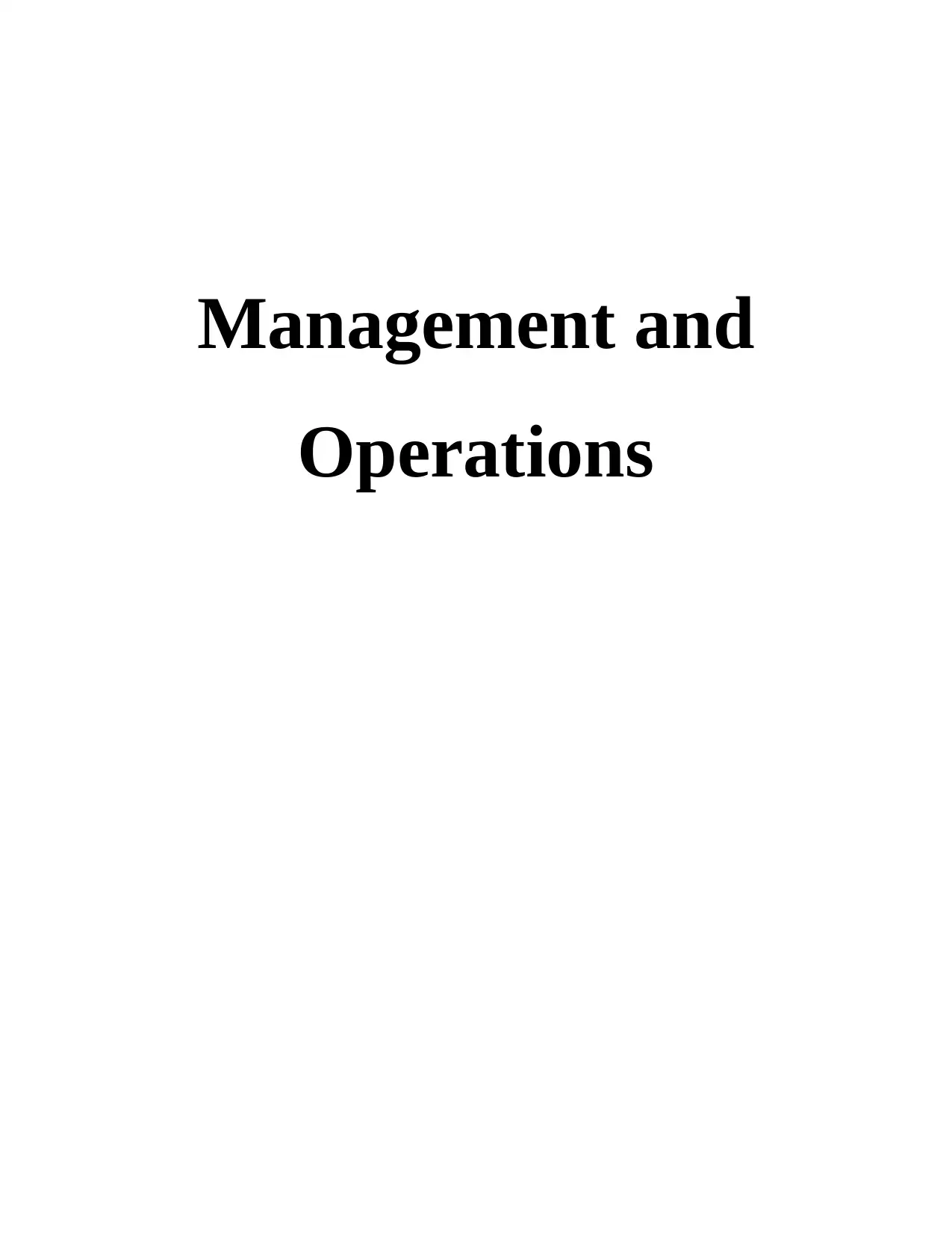
Management and
Operations
Operations
Paraphrase This Document
Need a fresh take? Get an instant paraphrase of this document with our AI Paraphraser
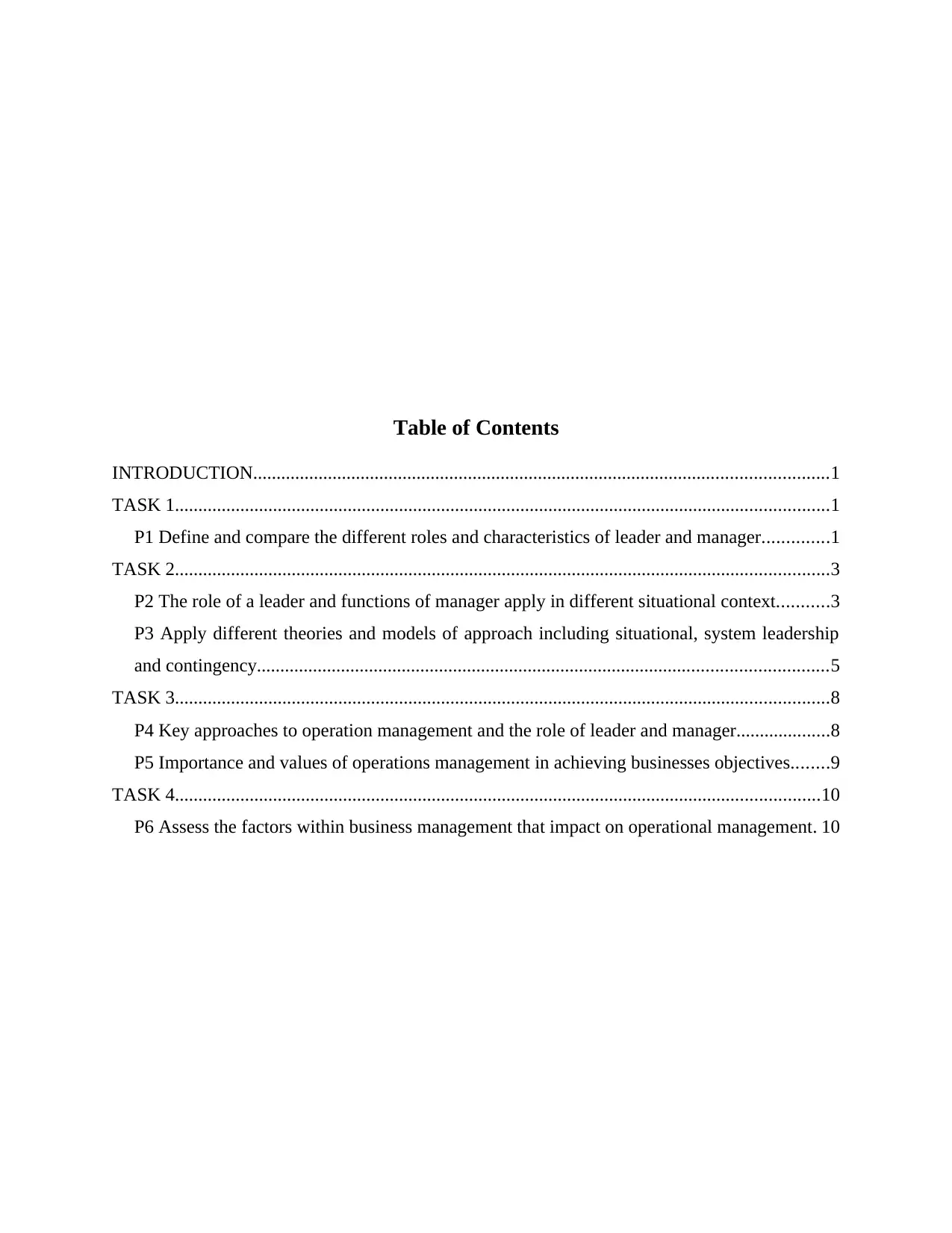
Table of Contents
INTRODUCTION...........................................................................................................................1
TASK 1............................................................................................................................................1
P1 Define and compare the different roles and characteristics of leader and manager..............1
TASK 2............................................................................................................................................3
P2 The role of a leader and functions of manager apply in different situational context...........3
P3 Apply different theories and models of approach including situational, system leadership
and contingency..........................................................................................................................5
TASK 3............................................................................................................................................8
P4 Key approaches to operation management and the role of leader and manager....................8
P5 Importance and values of operations management in achieving businesses objectives........9
TASK 4..........................................................................................................................................10
P6 Assess the factors within business management that impact on operational management. 10
INTRODUCTION...........................................................................................................................1
TASK 1............................................................................................................................................1
P1 Define and compare the different roles and characteristics of leader and manager..............1
TASK 2............................................................................................................................................3
P2 The role of a leader and functions of manager apply in different situational context...........3
P3 Apply different theories and models of approach including situational, system leadership
and contingency..........................................................................................................................5
TASK 3............................................................................................................................................8
P4 Key approaches to operation management and the role of leader and manager....................8
P5 Importance and values of operations management in achieving businesses objectives........9
TASK 4..........................................................................................................................................10
P6 Assess the factors within business management that impact on operational management. 10

⊘ This is a preview!⊘
Do you want full access?
Subscribe today to unlock all pages.

Trusted by 1+ million students worldwide

INTRODUCTION
Operation management is to be considered as the administration of business practices for
creating the highest level of efficiency as much as possible within organization. In this defined as
the procedure for converting raw materials, labor, capital, machine and methods into finished
goods in effective manner for maximizing profits (Brown and Bessant, 2013) . Management and
operation includes the plan and execution of strategies to run entire business operations with
efficient way. In other words, operation management play crucial role in utilizing available
resources such as staff, materials and technologies to get maximum outcomes with limited inputs
as well. This report is based on Mark and Spencer plc which is British multinational retailer and
its headquartered in London. This assignment will explain the role of leader and function of
manager that are applied in different situations within organization. It demonstrate the role of
leaders and manager that play in the operations function of firm. This report will define the
relationship between leadership and management in a contemporary business environment.
TASK 1
P1 Define and compare the different roles and characteristics of leader and manager
A good Leader and Manager assist the organization, to survive in market and compete
with its competitors. Both are necessary to increase efficiency in business and to motivate and
direct their employees and followers. Marks and Spencer Group plc (M&S) is a retailer in the
United Kingdom , with approximately 1,380 stores across the world. M&S run by its chairman
Archie Norman and chief executive Steve Rowe. The Company operates in two segments: UK
and International and offers food products of their brand, clothing and home decor products in
their online and offline stores. M&S has been in business for more than 125 years (Cass and
Mukherjee, 2011).
A Manager is one who manages the organisation and responsible for planning,
organising, directing, coordinating and controlling the business activities. Managers have the
ability to get their work done by the employees by using several strategies or ways and also have
the right to hire and fire them. In an organisation, different type of Managers are present on
different levels suchlike general Manager, project Manager and functional Manager. Some
basic qualities of Managers are efficient decision making, disciplined, committed to work, high
in confidence and have patience (Eriksson, LeBel and Lindroos, 2015) .
1
Operation management is to be considered as the administration of business practices for
creating the highest level of efficiency as much as possible within organization. In this defined as
the procedure for converting raw materials, labor, capital, machine and methods into finished
goods in effective manner for maximizing profits (Brown and Bessant, 2013) . Management and
operation includes the plan and execution of strategies to run entire business operations with
efficient way. In other words, operation management play crucial role in utilizing available
resources such as staff, materials and technologies to get maximum outcomes with limited inputs
as well. This report is based on Mark and Spencer plc which is British multinational retailer and
its headquartered in London. This assignment will explain the role of leader and function of
manager that are applied in different situations within organization. It demonstrate the role of
leaders and manager that play in the operations function of firm. This report will define the
relationship between leadership and management in a contemporary business environment.
TASK 1
P1 Define and compare the different roles and characteristics of leader and manager
A good Leader and Manager assist the organization, to survive in market and compete
with its competitors. Both are necessary to increase efficiency in business and to motivate and
direct their employees and followers. Marks and Spencer Group plc (M&S) is a retailer in the
United Kingdom , with approximately 1,380 stores across the world. M&S run by its chairman
Archie Norman and chief executive Steve Rowe. The Company operates in two segments: UK
and International and offers food products of their brand, clothing and home decor products in
their online and offline stores. M&S has been in business for more than 125 years (Cass and
Mukherjee, 2011).
A Manager is one who manages the organisation and responsible for planning,
organising, directing, coordinating and controlling the business activities. Managers have the
ability to get their work done by the employees by using several strategies or ways and also have
the right to hire and fire them. In an organisation, different type of Managers are present on
different levels suchlike general Manager, project Manager and functional Manager. Some
basic qualities of Managers are efficient decision making, disciplined, committed to work, high
in confidence and have patience (Eriksson, LeBel and Lindroos, 2015) .
1
Paraphrase This Document
Need a fresh take? Get an instant paraphrase of this document with our AI Paraphraser
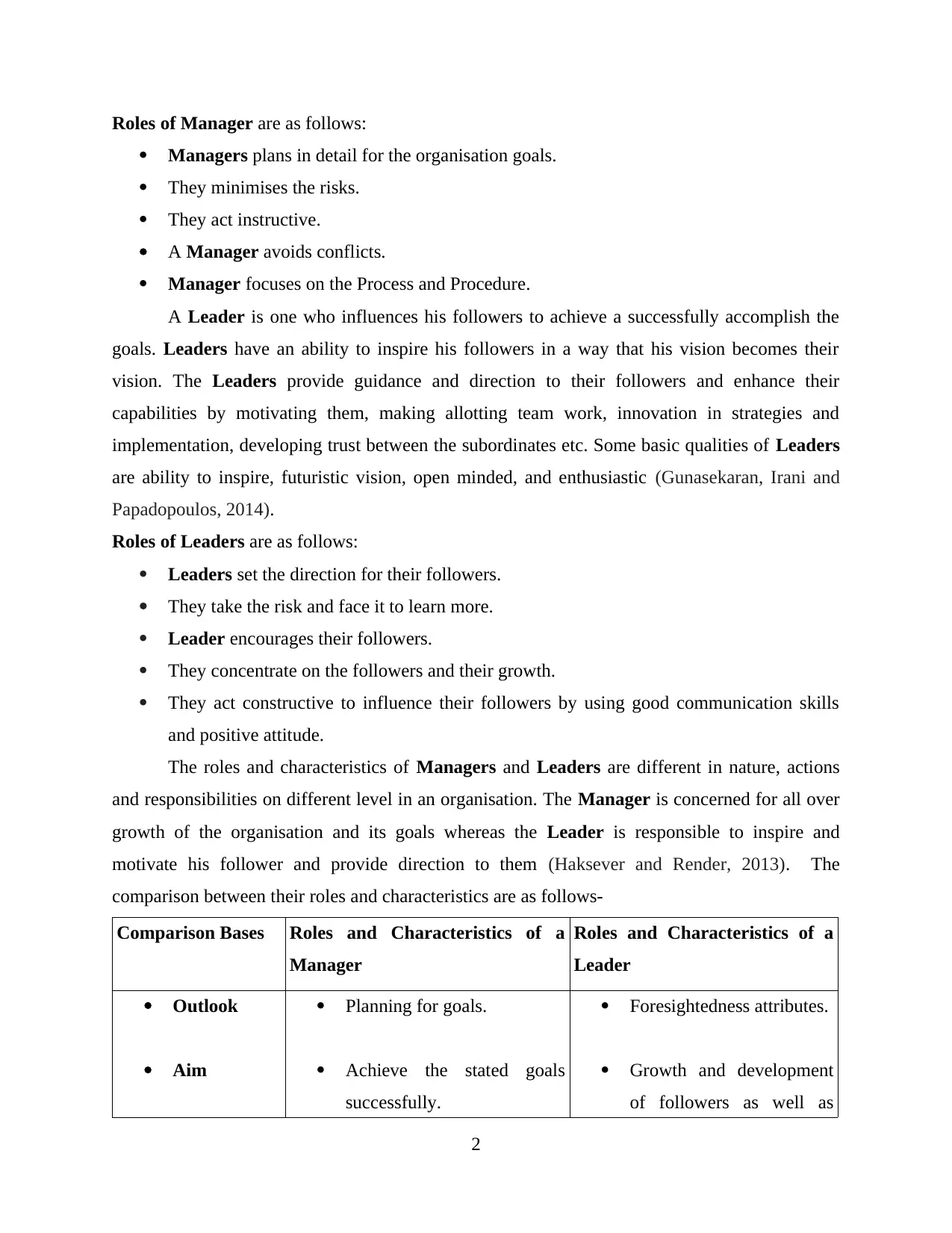
Roles of Manager are as follows:
Managers plans in detail for the organisation goals.
They minimises the risks.
They act instructive.
A Manager avoids conflicts.
Manager focuses on the Process and Procedure.
A Leader is one who influences his followers to achieve a successfully accomplish the
goals. Leaders have an ability to inspire his followers in a way that his vision becomes their
vision. The Leaders provide guidance and direction to their followers and enhance their
capabilities by motivating them, making allotting team work, innovation in strategies and
implementation, developing trust between the subordinates etc. Some basic qualities of Leaders
are ability to inspire, futuristic vision, open minded, and enthusiastic (Gunasekaran, Irani and
Papadopoulos, 2014).
Roles of Leaders are as follows:
Leaders set the direction for their followers.
They take the risk and face it to learn more.
Leader encourages their followers.
They concentrate on the followers and their growth.
They act constructive to influence their followers by using good communication skills
and positive attitude.
The roles and characteristics of Managers and Leaders are different in nature, actions
and responsibilities on different level in an organisation. The Manager is concerned for all over
growth of the organisation and its goals whereas the Leader is responsible to inspire and
motivate his follower and provide direction to them (Haksever and Render, 2013). The
comparison between their roles and characteristics are as follows-
Comparison Bases Roles and Characteristics of a
Manager
Roles and Characteristics of a
Leader
Outlook
Aim
Planning for goals.
Achieve the stated goals
successfully.
Foresightedness attributes.
Growth and development
of followers as well as
2
Managers plans in detail for the organisation goals.
They minimises the risks.
They act instructive.
A Manager avoids conflicts.
Manager focuses on the Process and Procedure.
A Leader is one who influences his followers to achieve a successfully accomplish the
goals. Leaders have an ability to inspire his followers in a way that his vision becomes their
vision. The Leaders provide guidance and direction to their followers and enhance their
capabilities by motivating them, making allotting team work, innovation in strategies and
implementation, developing trust between the subordinates etc. Some basic qualities of Leaders
are ability to inspire, futuristic vision, open minded, and enthusiastic (Gunasekaran, Irani and
Papadopoulos, 2014).
Roles of Leaders are as follows:
Leaders set the direction for their followers.
They take the risk and face it to learn more.
Leader encourages their followers.
They concentrate on the followers and their growth.
They act constructive to influence their followers by using good communication skills
and positive attitude.
The roles and characteristics of Managers and Leaders are different in nature, actions
and responsibilities on different level in an organisation. The Manager is concerned for all over
growth of the organisation and its goals whereas the Leader is responsible to inspire and
motivate his follower and provide direction to them (Haksever and Render, 2013). The
comparison between their roles and characteristics are as follows-
Comparison Bases Roles and Characteristics of a
Manager
Roles and Characteristics of a
Leader
Outlook
Aim
Planning for goals.
Achieve the stated goals
successfully.
Foresightedness attributes.
Growth and development
of followers as well as
2
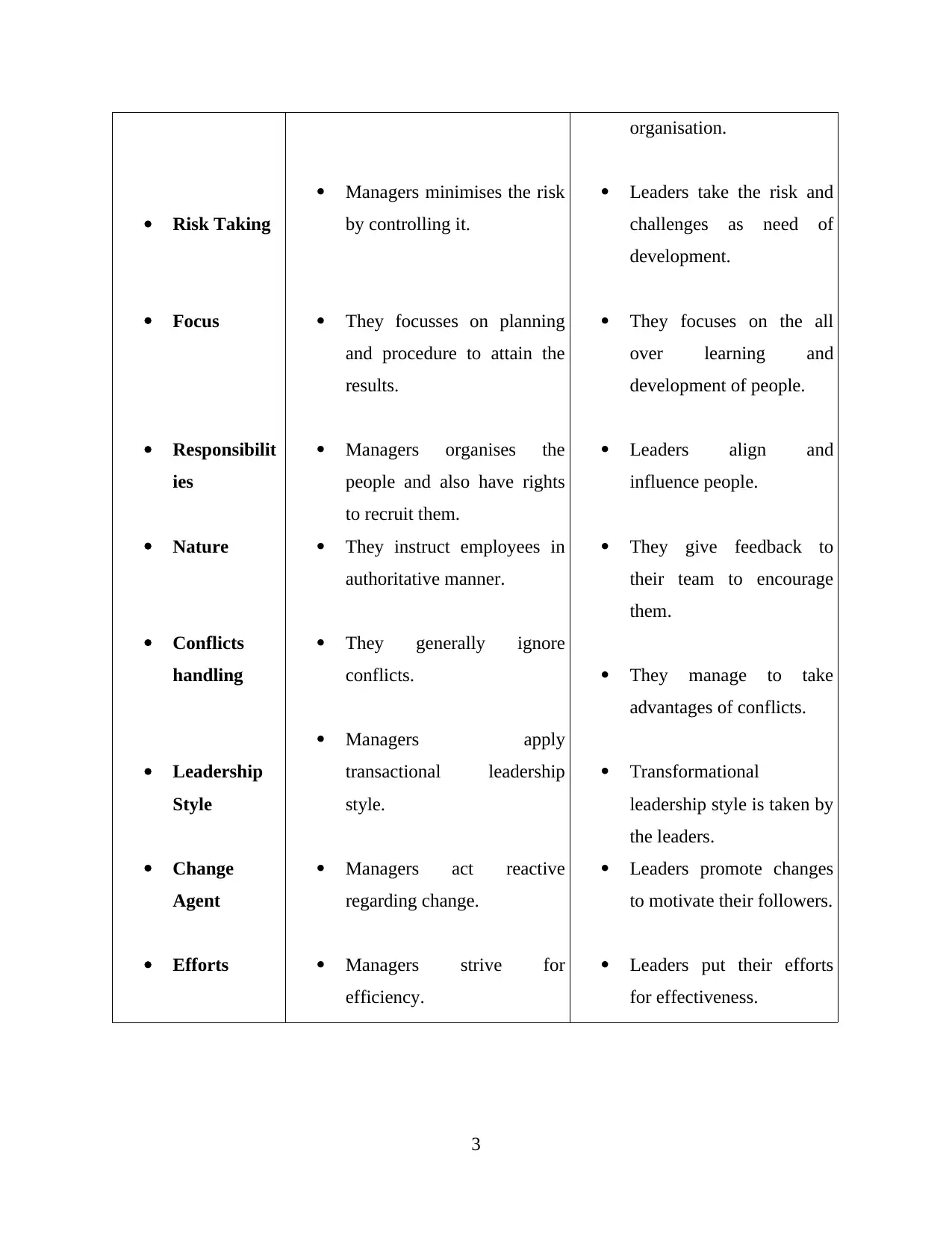
Risk Taking
Focus
Responsibilit
ies
Nature
Conflicts
handling
Leadership
Style
Change
Agent
Efforts
Managers minimises the risk
by controlling it.
They focusses on planning
and procedure to attain the
results.
Managers organises the
people and also have rights
to recruit them.
They instruct employees in
authoritative manner.
They generally ignore
conflicts.
Managers apply
transactional leadership
style.
Managers act reactive
regarding change.
Managers strive for
efficiency.
organisation.
Leaders take the risk and
challenges as need of
development.
They focuses on the all
over learning and
development of people.
Leaders align and
influence people.
They give feedback to
their team to encourage
them.
They manage to take
advantages of conflicts.
Transformational
leadership style is taken by
the leaders.
Leaders promote changes
to motivate their followers.
Leaders put their efforts
for effectiveness.
3
Focus
Responsibilit
ies
Nature
Conflicts
handling
Leadership
Style
Change
Agent
Efforts
Managers minimises the risk
by controlling it.
They focusses on planning
and procedure to attain the
results.
Managers organises the
people and also have rights
to recruit them.
They instruct employees in
authoritative manner.
They generally ignore
conflicts.
Managers apply
transactional leadership
style.
Managers act reactive
regarding change.
Managers strive for
efficiency.
organisation.
Leaders take the risk and
challenges as need of
development.
They focuses on the all
over learning and
development of people.
Leaders align and
influence people.
They give feedback to
their team to encourage
them.
They manage to take
advantages of conflicts.
Transformational
leadership style is taken by
the leaders.
Leaders promote changes
to motivate their followers.
Leaders put their efforts
for effectiveness.
3
⊘ This is a preview!⊘
Do you want full access?
Subscribe today to unlock all pages.

Trusted by 1+ million students worldwide
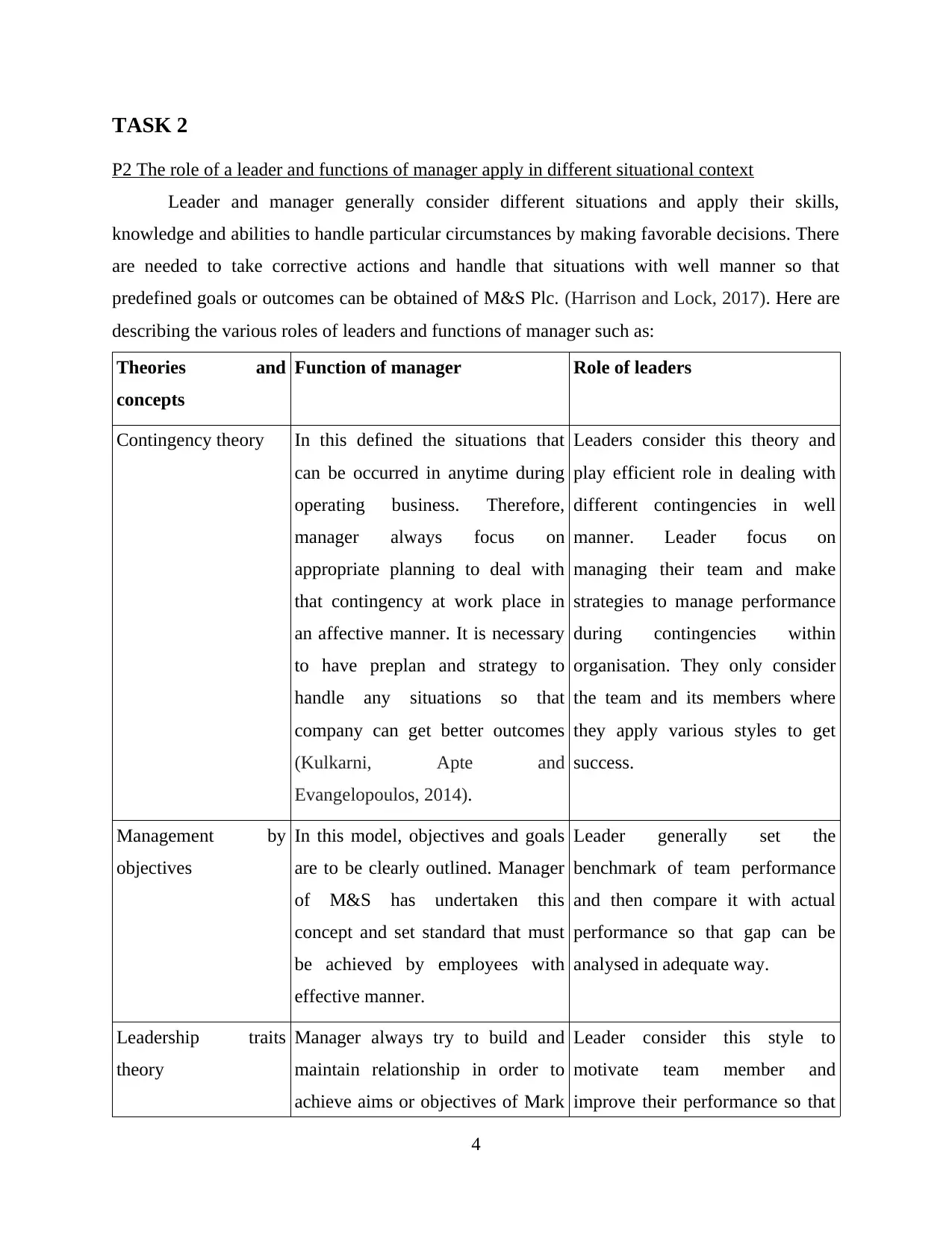
TASK 2
P2 The role of a leader and functions of manager apply in different situational context
Leader and manager generally consider different situations and apply their skills,
knowledge and abilities to handle particular circumstances by making favorable decisions. There
are needed to take corrective actions and handle that situations with well manner so that
predefined goals or outcomes can be obtained of M&S Plc. (Harrison and Lock, 2017). Here are
describing the various roles of leaders and functions of manager such as:
Theories and
concepts
Function of manager Role of leaders
Contingency theory In this defined the situations that
can be occurred in anytime during
operating business. Therefore,
manager always focus on
appropriate planning to deal with
that contingency at work place in
an affective manner. It is necessary
to have preplan and strategy to
handle any situations so that
company can get better outcomes
(Kulkarni, Apte and
Evangelopoulos, 2014).
Leaders consider this theory and
play efficient role in dealing with
different contingencies in well
manner. Leader focus on
managing their team and make
strategies to manage performance
during contingencies within
organisation. They only consider
the team and its members where
they apply various styles to get
success.
Management by
objectives
In this model, objectives and goals
are to be clearly outlined. Manager
of M&S has undertaken this
concept and set standard that must
be achieved by employees with
effective manner.
Leader generally set the
benchmark of team performance
and then compare it with actual
performance so that gap can be
analysed in adequate way.
Leadership traits
theory
Manager always try to build and
maintain relationship in order to
achieve aims or objectives of Mark
Leader consider this style to
motivate team member and
improve their performance so that
4
P2 The role of a leader and functions of manager apply in different situational context
Leader and manager generally consider different situations and apply their skills,
knowledge and abilities to handle particular circumstances by making favorable decisions. There
are needed to take corrective actions and handle that situations with well manner so that
predefined goals or outcomes can be obtained of M&S Plc. (Harrison and Lock, 2017). Here are
describing the various roles of leaders and functions of manager such as:
Theories and
concepts
Function of manager Role of leaders
Contingency theory In this defined the situations that
can be occurred in anytime during
operating business. Therefore,
manager always focus on
appropriate planning to deal with
that contingency at work place in
an affective manner. It is necessary
to have preplan and strategy to
handle any situations so that
company can get better outcomes
(Kulkarni, Apte and
Evangelopoulos, 2014).
Leaders consider this theory and
play efficient role in dealing with
different contingencies in well
manner. Leader focus on
managing their team and make
strategies to manage performance
during contingencies within
organisation. They only consider
the team and its members where
they apply various styles to get
success.
Management by
objectives
In this model, objectives and goals
are to be clearly outlined. Manager
of M&S has undertaken this
concept and set standard that must
be achieved by employees with
effective manner.
Leader generally set the
benchmark of team performance
and then compare it with actual
performance so that gap can be
analysed in adequate way.
Leadership traits
theory
Manager always try to build and
maintain relationship in order to
achieve aims or objectives of Mark
Leader consider this style to
motivate team member and
improve their performance so that
4
Paraphrase This Document
Need a fresh take? Get an instant paraphrase of this document with our AI Paraphraser
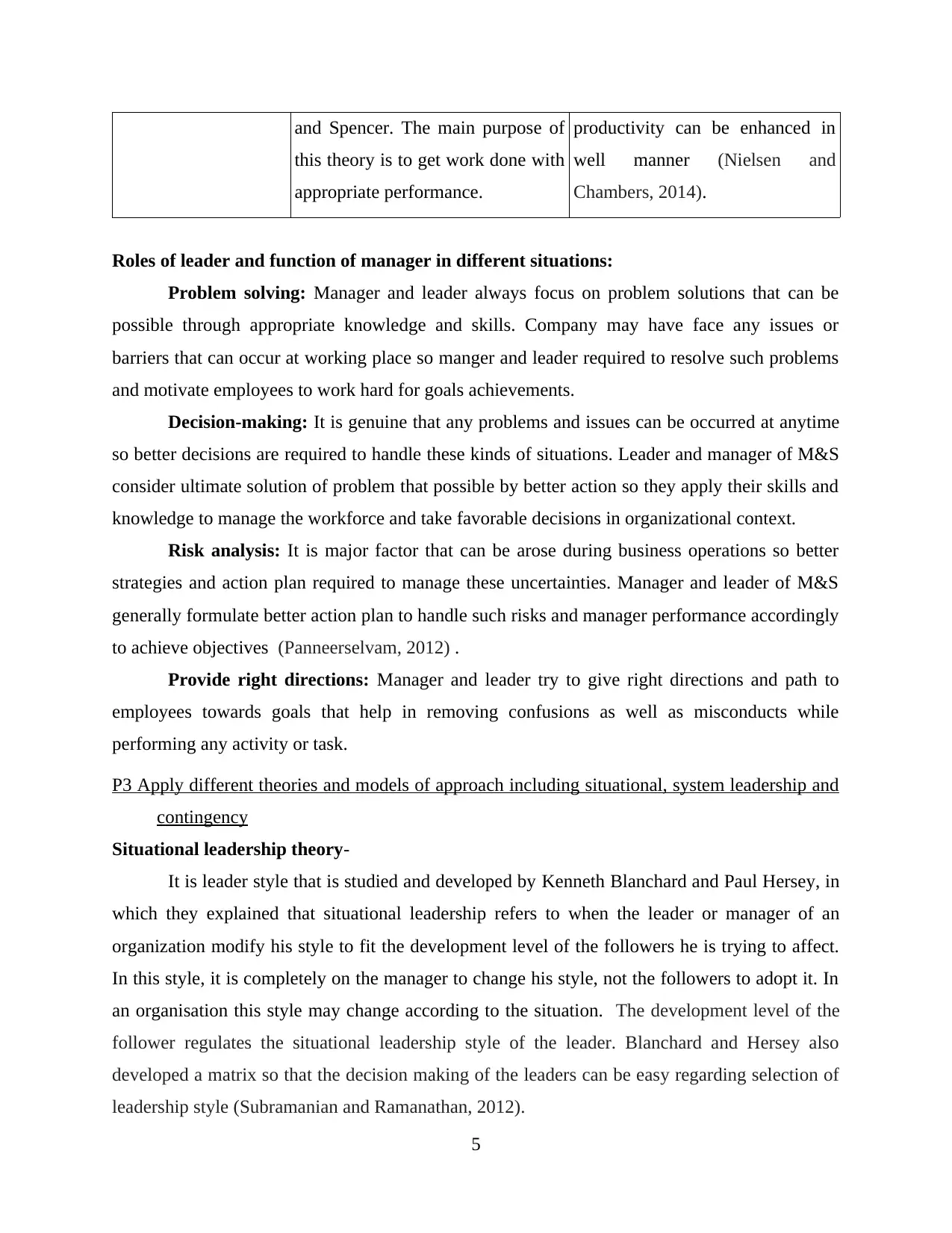
and Spencer. The main purpose of
this theory is to get work done with
appropriate performance.
productivity can be enhanced in
well manner (Nielsen and
Chambers, 2014).
Roles of leader and function of manager in different situations:
Problem solving: Manager and leader always focus on problem solutions that can be
possible through appropriate knowledge and skills. Company may have face any issues or
barriers that can occur at working place so manger and leader required to resolve such problems
and motivate employees to work hard for goals achievements.
Decision-making: It is genuine that any problems and issues can be occurred at anytime
so better decisions are required to handle these kinds of situations. Leader and manager of M&S
consider ultimate solution of problem that possible by better action so they apply their skills and
knowledge to manage the workforce and take favorable decisions in organizational context.
Risk analysis: It is major factor that can be arose during business operations so better
strategies and action plan required to manage these uncertainties. Manager and leader of M&S
generally formulate better action plan to handle such risks and manager performance accordingly
to achieve objectives (Panneerselvam, 2012) .
Provide right directions: Manager and leader try to give right directions and path to
employees towards goals that help in removing confusions as well as misconducts while
performing any activity or task.
P3 Apply different theories and models of approach including situational, system leadership and
contingency
Situational leadership theory-
It is leader style that is studied and developed by Kenneth Blanchard and Paul Hersey, in
which they explained that situational leadership refers to when the leader or manager of an
organization modify his style to fit the development level of the followers he is trying to affect.
In this style, it is completely on the manager to change his style, not the followers to adopt it. In
an organisation this style may change according to the situation. The development level of the
follower regulates the situational leadership style of the leader. Blanchard and Hersey also
developed a matrix so that the decision making of the leaders can be easy regarding selection of
leadership style (Subramanian and Ramanathan, 2012).
5
this theory is to get work done with
appropriate performance.
productivity can be enhanced in
well manner (Nielsen and
Chambers, 2014).
Roles of leader and function of manager in different situations:
Problem solving: Manager and leader always focus on problem solutions that can be
possible through appropriate knowledge and skills. Company may have face any issues or
barriers that can occur at working place so manger and leader required to resolve such problems
and motivate employees to work hard for goals achievements.
Decision-making: It is genuine that any problems and issues can be occurred at anytime
so better decisions are required to handle these kinds of situations. Leader and manager of M&S
consider ultimate solution of problem that possible by better action so they apply their skills and
knowledge to manage the workforce and take favorable decisions in organizational context.
Risk analysis: It is major factor that can be arose during business operations so better
strategies and action plan required to manage these uncertainties. Manager and leader of M&S
generally formulate better action plan to handle such risks and manager performance accordingly
to achieve objectives (Panneerselvam, 2012) .
Provide right directions: Manager and leader try to give right directions and path to
employees towards goals that help in removing confusions as well as misconducts while
performing any activity or task.
P3 Apply different theories and models of approach including situational, system leadership and
contingency
Situational leadership theory-
It is leader style that is studied and developed by Kenneth Blanchard and Paul Hersey, in
which they explained that situational leadership refers to when the leader or manager of an
organization modify his style to fit the development level of the followers he is trying to affect.
In this style, it is completely on the manager to change his style, not the followers to adopt it. In
an organisation this style may change according to the situation. The development level of the
follower regulates the situational leadership style of the leader. Blanchard and Hersey also
developed a matrix so that the decision making of the leaders can be easy regarding selection of
leadership style (Subramanian and Ramanathan, 2012).
5
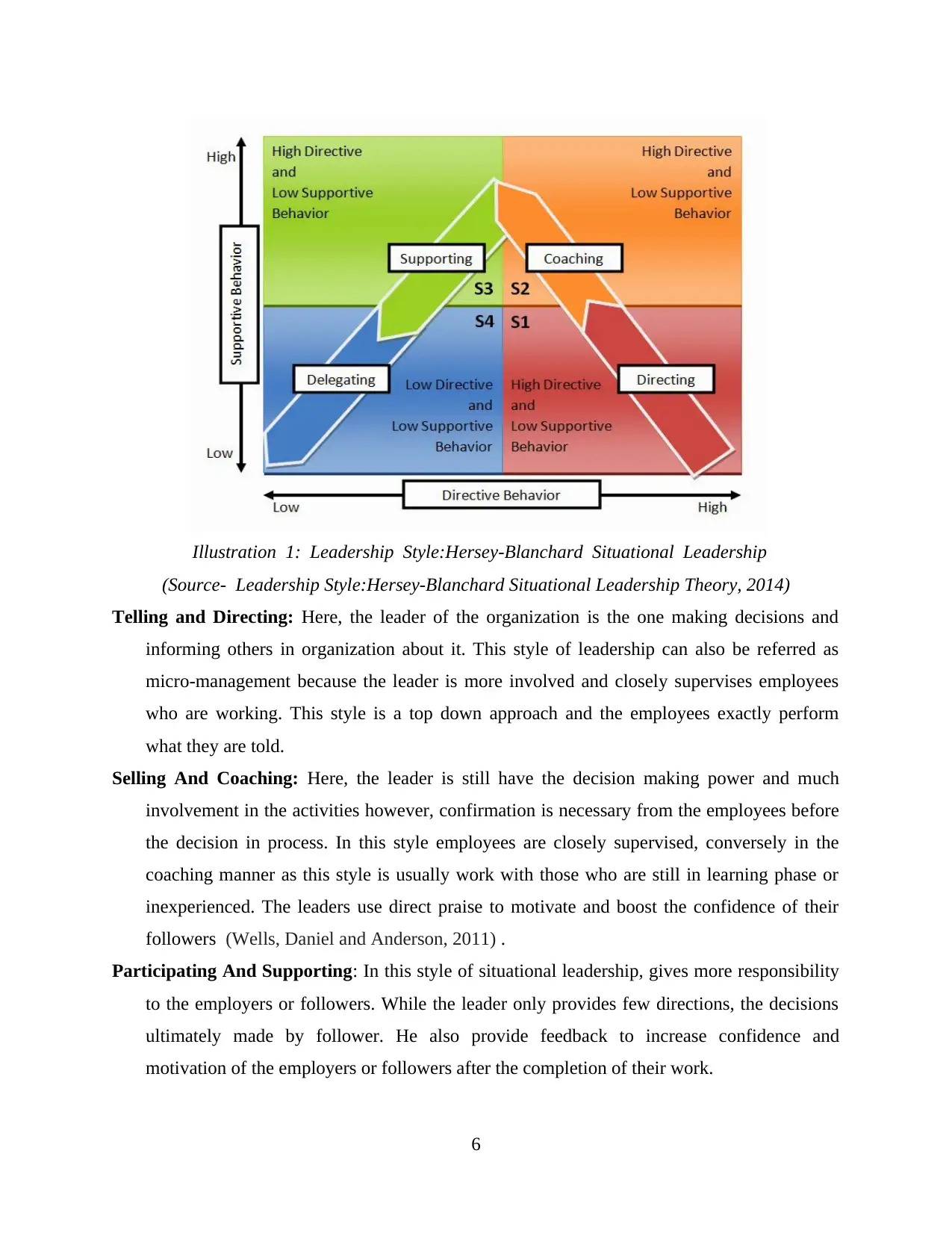
(Source- Leadership Style:Hersey-Blanchard Situational Leadership Theory, 2014)
Telling and Directing: Here, the leader of the organization is the one making decisions and
informing others in organization about it. This style of leadership can also be referred as
micro-management because the leader is more involved and closely supervises employees
who are working. This style is a top down approach and the employees exactly perform
what they are told.
Selling And Coaching: Here, the leader is still have the decision making power and much
involvement in the activities however, confirmation is necessary from the employees before
the decision in process. In this style employees are closely supervised, conversely in the
coaching manner as this style is usually work with those who are still in learning phase or
inexperienced. The leaders use direct praise to motivate and boost the confidence of their
followers (Wells, Daniel and Anderson, 2011) .
Participating And Supporting: In this style of situational leadership, gives more responsibility
to the employers or followers. While the leader only provides few directions, the decisions
ultimately made by follower. He also provide feedback to increase confidence and
motivation of the employers or followers after the completion of their work.
6
Illustration 1: Leadership Style:Hersey-Blanchard Situational Leadership
Theory
Telling and Directing: Here, the leader of the organization is the one making decisions and
informing others in organization about it. This style of leadership can also be referred as
micro-management because the leader is more involved and closely supervises employees
who are working. This style is a top down approach and the employees exactly perform
what they are told.
Selling And Coaching: Here, the leader is still have the decision making power and much
involvement in the activities however, confirmation is necessary from the employees before
the decision in process. In this style employees are closely supervised, conversely in the
coaching manner as this style is usually work with those who are still in learning phase or
inexperienced. The leaders use direct praise to motivate and boost the confidence of their
followers (Wells, Daniel and Anderson, 2011) .
Participating And Supporting: In this style of situational leadership, gives more responsibility
to the employers or followers. While the leader only provides few directions, the decisions
ultimately made by follower. He also provide feedback to increase confidence and
motivation of the employers or followers after the completion of their work.
6
Illustration 1: Leadership Style:Hersey-Blanchard Situational Leadership
Theory
⊘ This is a preview!⊘
Do you want full access?
Subscribe today to unlock all pages.

Trusted by 1+ million students worldwide
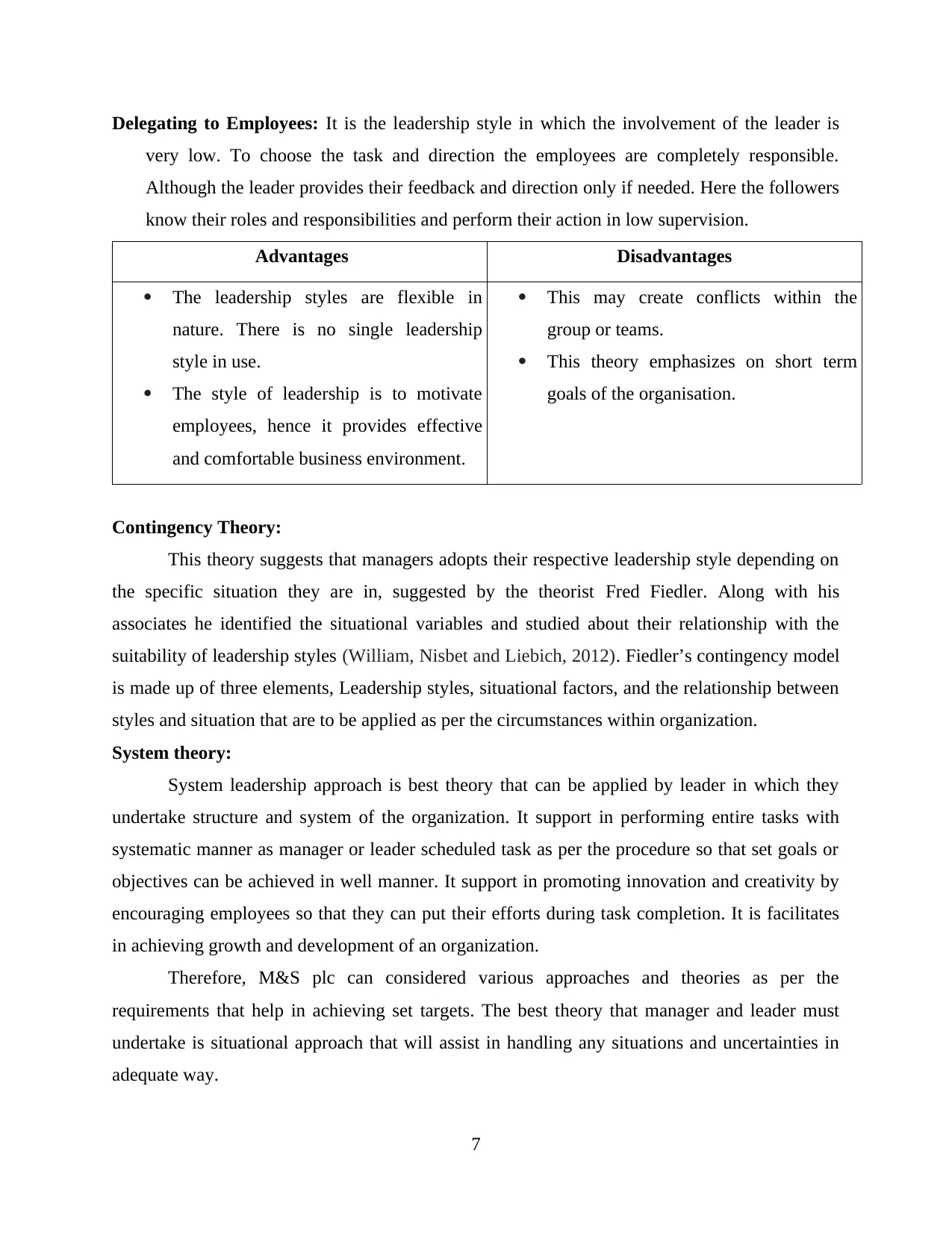
Delegating to Employees: It is the leadership style in which the involvement of the leader is
very low. To choose the task and direction the employees are completely responsible.
Although the leader provides their feedback and direction only if needed. Here the followers
know their roles and responsibilities and perform their action in low supervision.
Advantages Disadvantages
The leadership styles are flexible in
nature. There is no single leadership
style in use.
The style of leadership is to motivate
employees, hence it provides effective
and comfortable business environment.
This may create conflicts within the
group or teams.
This theory emphasizes on short term
goals of the organisation.
Contingency Theory:
This theory suggests that managers adopts their respective leadership style depending on
the specific situation they are in, suggested by the theorist Fred Fiedler. Along with his
associates he identified the situational variables and studied about their relationship with the
suitability of leadership styles (William, Nisbet and Liebich, 2012). Fiedler’s contingency model
is made up of three elements, Leadership styles, situational factors, and the relationship between
styles and situation that are to be applied as per the circumstances within organization.
System theory:
System leadership approach is best theory that can be applied by leader in which they
undertake structure and system of the organization. It support in performing entire tasks with
systematic manner as manager or leader scheduled task as per the procedure so that set goals or
objectives can be achieved in well manner. It support in promoting innovation and creativity by
encouraging employees so that they can put their efforts during task completion. It is facilitates
in achieving growth and development of an organization.
Therefore, M&S plc can considered various approaches and theories as per the
requirements that help in achieving set targets. The best theory that manager and leader must
undertake is situational approach that will assist in handling any situations and uncertainties in
adequate way.
7
very low. To choose the task and direction the employees are completely responsible.
Although the leader provides their feedback and direction only if needed. Here the followers
know their roles and responsibilities and perform their action in low supervision.
Advantages Disadvantages
The leadership styles are flexible in
nature. There is no single leadership
style in use.
The style of leadership is to motivate
employees, hence it provides effective
and comfortable business environment.
This may create conflicts within the
group or teams.
This theory emphasizes on short term
goals of the organisation.
Contingency Theory:
This theory suggests that managers adopts their respective leadership style depending on
the specific situation they are in, suggested by the theorist Fred Fiedler. Along with his
associates he identified the situational variables and studied about their relationship with the
suitability of leadership styles (William, Nisbet and Liebich, 2012). Fiedler’s contingency model
is made up of three elements, Leadership styles, situational factors, and the relationship between
styles and situation that are to be applied as per the circumstances within organization.
System theory:
System leadership approach is best theory that can be applied by leader in which they
undertake structure and system of the organization. It support in performing entire tasks with
systematic manner as manager or leader scheduled task as per the procedure so that set goals or
objectives can be achieved in well manner. It support in promoting innovation and creativity by
encouraging employees so that they can put their efforts during task completion. It is facilitates
in achieving growth and development of an organization.
Therefore, M&S plc can considered various approaches and theories as per the
requirements that help in achieving set targets. The best theory that manager and leader must
undertake is situational approach that will assist in handling any situations and uncertainties in
adequate way.
7
Paraphrase This Document
Need a fresh take? Get an instant paraphrase of this document with our AI Paraphraser
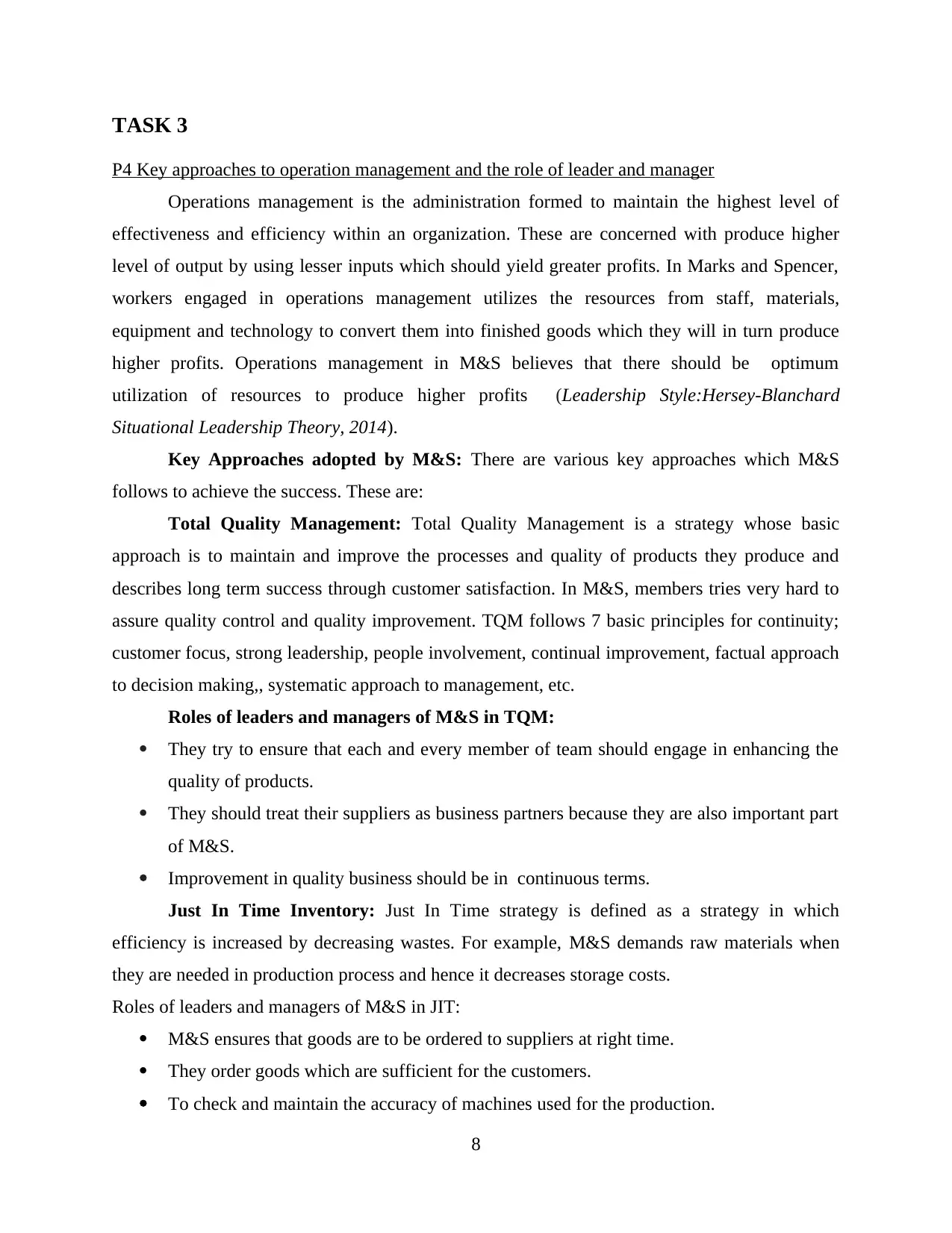
TASK 3
P4 Key approaches to operation management and the role of leader and manager
Operations management is the administration formed to maintain the highest level of
effectiveness and efficiency within an organization. These are concerned with produce higher
level of output by using lesser inputs which should yield greater profits. In Marks and Spencer,
workers engaged in operations management utilizes the resources from staff, materials,
equipment and technology to convert them into finished goods which they will in turn produce
higher profits. Operations management in M&S believes that there should be optimum
utilization of resources to produce higher profits (Leadership Style:Hersey-Blanchard
Situational Leadership Theory, 2014).
Key Approaches adopted by M&S: There are various key approaches which M&S
follows to achieve the success. These are:
Total Quality Management: Total Quality Management is a strategy whose basic
approach is to maintain and improve the processes and quality of products they produce and
describes long term success through customer satisfaction. In M&S, members tries very hard to
assure quality control and quality improvement. TQM follows 7 basic principles for continuity;
customer focus, strong leadership, people involvement, continual improvement, factual approach
to decision making,, systematic approach to management, etc.
Roles of leaders and managers of M&S in TQM:
They try to ensure that each and every member of team should engage in enhancing the
quality of products.
They should treat their suppliers as business partners because they are also important part
of M&S.
Improvement in quality business should be in continuous terms.
Just In Time Inventory: Just In Time strategy is defined as a strategy in which
efficiency is increased by decreasing wastes. For example, M&S demands raw materials when
they are needed in production process and hence it decreases storage costs.
Roles of leaders and managers of M&S in JIT:
M&S ensures that goods are to be ordered to suppliers at right time.
They order goods which are sufficient for the customers.
To check and maintain the accuracy of machines used for the production.
8
P4 Key approaches to operation management and the role of leader and manager
Operations management is the administration formed to maintain the highest level of
effectiveness and efficiency within an organization. These are concerned with produce higher
level of output by using lesser inputs which should yield greater profits. In Marks and Spencer,
workers engaged in operations management utilizes the resources from staff, materials,
equipment and technology to convert them into finished goods which they will in turn produce
higher profits. Operations management in M&S believes that there should be optimum
utilization of resources to produce higher profits (Leadership Style:Hersey-Blanchard
Situational Leadership Theory, 2014).
Key Approaches adopted by M&S: There are various key approaches which M&S
follows to achieve the success. These are:
Total Quality Management: Total Quality Management is a strategy whose basic
approach is to maintain and improve the processes and quality of products they produce and
describes long term success through customer satisfaction. In M&S, members tries very hard to
assure quality control and quality improvement. TQM follows 7 basic principles for continuity;
customer focus, strong leadership, people involvement, continual improvement, factual approach
to decision making,, systematic approach to management, etc.
Roles of leaders and managers of M&S in TQM:
They try to ensure that each and every member of team should engage in enhancing the
quality of products.
They should treat their suppliers as business partners because they are also important part
of M&S.
Improvement in quality business should be in continuous terms.
Just In Time Inventory: Just In Time strategy is defined as a strategy in which
efficiency is increased by decreasing wastes. For example, M&S demands raw materials when
they are needed in production process and hence it decreases storage costs.
Roles of leaders and managers of M&S in JIT:
M&S ensures that goods are to be ordered to suppliers at right time.
They order goods which are sufficient for the customers.
To check and maintain the accuracy of machines used for the production.
8
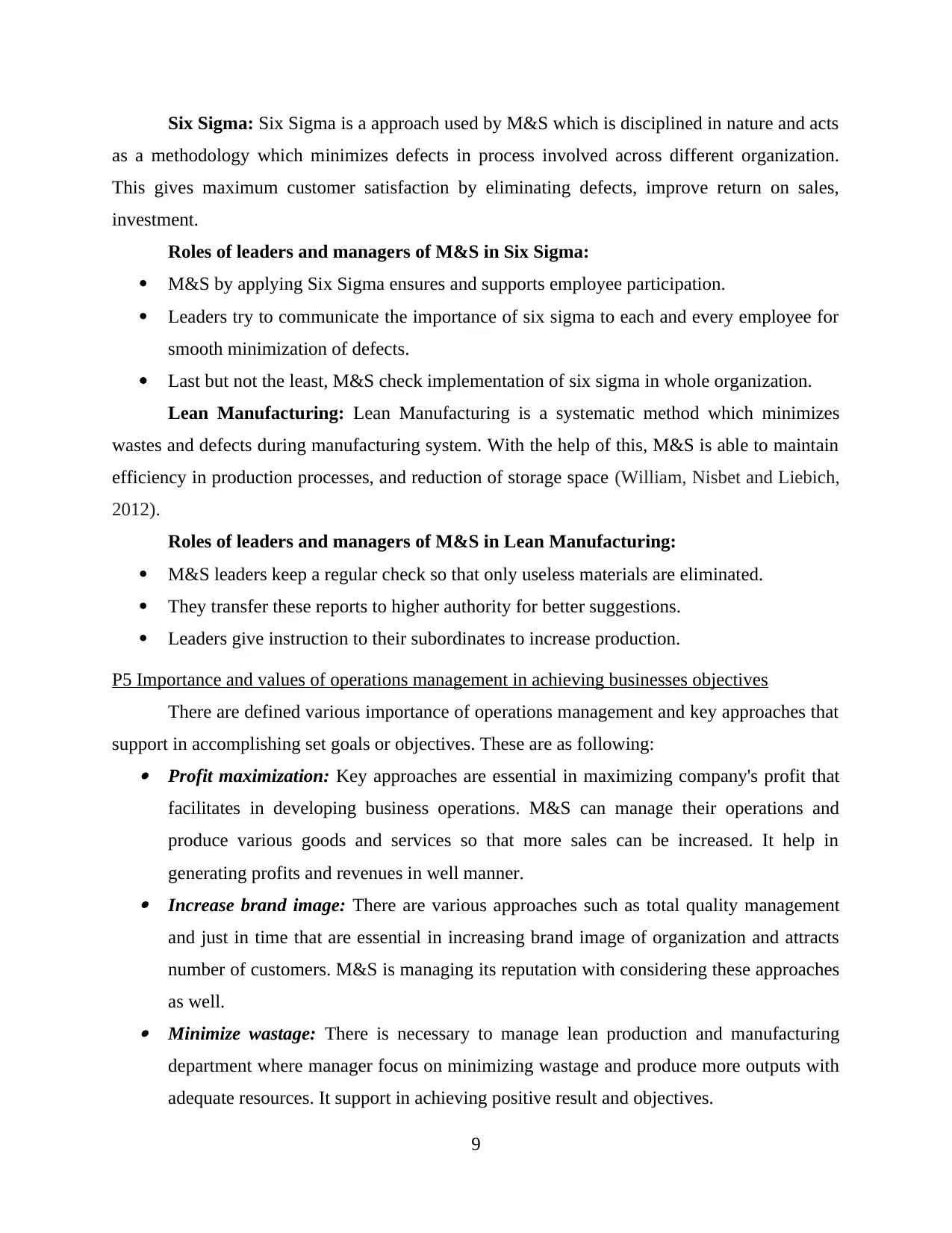
Six Sigma: Six Sigma is a approach used by M&S which is disciplined in nature and acts
as a methodology which minimizes defects in process involved across different organization.
This gives maximum customer satisfaction by eliminating defects, improve return on sales,
investment.
Roles of leaders and managers of M&S in Six Sigma:
M&S by applying Six Sigma ensures and supports employee participation.
Leaders try to communicate the importance of six sigma to each and every employee for
smooth minimization of defects.
Last but not the least, M&S check implementation of six sigma in whole organization.
Lean Manufacturing: Lean Manufacturing is a systematic method which minimizes
wastes and defects during manufacturing system. With the help of this, M&S is able to maintain
efficiency in production processes, and reduction of storage space (William, Nisbet and Liebich,
2012).
Roles of leaders and managers of M&S in Lean Manufacturing:
M&S leaders keep a regular check so that only useless materials are eliminated.
They transfer these reports to higher authority for better suggestions.
Leaders give instruction to their subordinates to increase production.
P5 Importance and values of operations management in achieving businesses objectives
There are defined various importance of operations management and key approaches that
support in accomplishing set goals or objectives. These are as following: Profit maximization: Key approaches are essential in maximizing company's profit that
facilitates in developing business operations. M&S can manage their operations and
produce various goods and services so that more sales can be increased. It help in
generating profits and revenues in well manner. Increase brand image: There are various approaches such as total quality management
and just in time that are essential in increasing brand image of organization and attracts
number of customers. M&S is managing its reputation with considering these approaches
as well. Minimize wastage: There is necessary to manage lean production and manufacturing
department where manager focus on minimizing wastage and produce more outputs with
adequate resources. It support in achieving positive result and objectives.
9
as a methodology which minimizes defects in process involved across different organization.
This gives maximum customer satisfaction by eliminating defects, improve return on sales,
investment.
Roles of leaders and managers of M&S in Six Sigma:
M&S by applying Six Sigma ensures and supports employee participation.
Leaders try to communicate the importance of six sigma to each and every employee for
smooth minimization of defects.
Last but not the least, M&S check implementation of six sigma in whole organization.
Lean Manufacturing: Lean Manufacturing is a systematic method which minimizes
wastes and defects during manufacturing system. With the help of this, M&S is able to maintain
efficiency in production processes, and reduction of storage space (William, Nisbet and Liebich,
2012).
Roles of leaders and managers of M&S in Lean Manufacturing:
M&S leaders keep a regular check so that only useless materials are eliminated.
They transfer these reports to higher authority for better suggestions.
Leaders give instruction to their subordinates to increase production.
P5 Importance and values of operations management in achieving businesses objectives
There are defined various importance of operations management and key approaches that
support in accomplishing set goals or objectives. These are as following: Profit maximization: Key approaches are essential in maximizing company's profit that
facilitates in developing business operations. M&S can manage their operations and
produce various goods and services so that more sales can be increased. It help in
generating profits and revenues in well manner. Increase brand image: There are various approaches such as total quality management
and just in time that are essential in increasing brand image of organization and attracts
number of customers. M&S is managing its reputation with considering these approaches
as well. Minimize wastage: There is necessary to manage lean production and manufacturing
department where manager focus on minimizing wastage and produce more outputs with
adequate resources. It support in achieving positive result and objectives.
9
⊘ This is a preview!⊘
Do you want full access?
Subscribe today to unlock all pages.

Trusted by 1+ million students worldwide
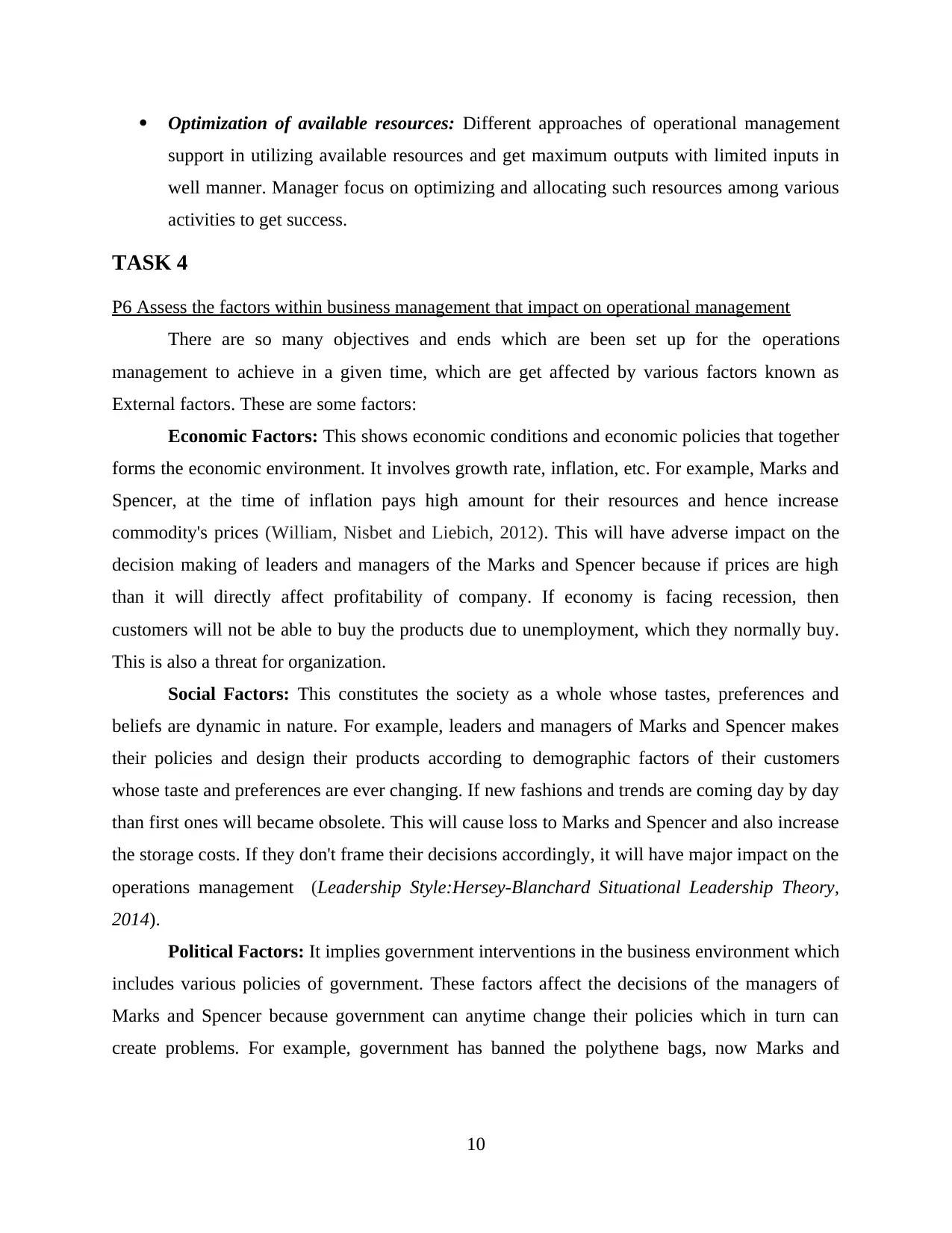
Optimization of available resources: Different approaches of operational management
support in utilizing available resources and get maximum outputs with limited inputs in
well manner. Manager focus on optimizing and allocating such resources among various
activities to get success.
TASK 4
P6 Assess the factors within business management that impact on operational management
There are so many objectives and ends which are been set up for the operations
management to achieve in a given time, which are get affected by various factors known as
External factors. These are some factors:
Economic Factors: This shows economic conditions and economic policies that together
forms the economic environment. It involves growth rate, inflation, etc. For example, Marks and
Spencer, at the time of inflation pays high amount for their resources and hence increase
commodity's prices (William, Nisbet and Liebich, 2012). This will have adverse impact on the
decision making of leaders and managers of the Marks and Spencer because if prices are high
than it will directly affect profitability of company. If economy is facing recession, then
customers will not be able to buy the products due to unemployment, which they normally buy.
This is also a threat for organization.
Social Factors: This constitutes the society as a whole whose tastes, preferences and
beliefs are dynamic in nature. For example, leaders and managers of Marks and Spencer makes
their policies and design their products according to demographic factors of their customers
whose taste and preferences are ever changing. If new fashions and trends are coming day by day
than first ones will became obsolete. This will cause loss to Marks and Spencer and also increase
the storage costs. If they don't frame their decisions accordingly, it will have major impact on the
operations management (Leadership Style:Hersey-Blanchard Situational Leadership Theory,
2014).
Political Factors: It implies government interventions in the business environment which
includes various policies of government. These factors affect the decisions of the managers of
Marks and Spencer because government can anytime change their policies which in turn can
create problems. For example, government has banned the polythene bags, now Marks and
10
support in utilizing available resources and get maximum outputs with limited inputs in
well manner. Manager focus on optimizing and allocating such resources among various
activities to get success.
TASK 4
P6 Assess the factors within business management that impact on operational management
There are so many objectives and ends which are been set up for the operations
management to achieve in a given time, which are get affected by various factors known as
External factors. These are some factors:
Economic Factors: This shows economic conditions and economic policies that together
forms the economic environment. It involves growth rate, inflation, etc. For example, Marks and
Spencer, at the time of inflation pays high amount for their resources and hence increase
commodity's prices (William, Nisbet and Liebich, 2012). This will have adverse impact on the
decision making of leaders and managers of the Marks and Spencer because if prices are high
than it will directly affect profitability of company. If economy is facing recession, then
customers will not be able to buy the products due to unemployment, which they normally buy.
This is also a threat for organization.
Social Factors: This constitutes the society as a whole whose tastes, preferences and
beliefs are dynamic in nature. For example, leaders and managers of Marks and Spencer makes
their policies and design their products according to demographic factors of their customers
whose taste and preferences are ever changing. If new fashions and trends are coming day by day
than first ones will became obsolete. This will cause loss to Marks and Spencer and also increase
the storage costs. If they don't frame their decisions accordingly, it will have major impact on the
operations management (Leadership Style:Hersey-Blanchard Situational Leadership Theory,
2014).
Political Factors: It implies government interventions in the business environment which
includes various policies of government. These factors affect the decisions of the managers of
Marks and Spencer because government can anytime change their policies which in turn can
create problems. For example, government has banned the polythene bags, now Marks and
10
Paraphrase This Document
Need a fresh take? Get an instant paraphrase of this document with our AI Paraphraser
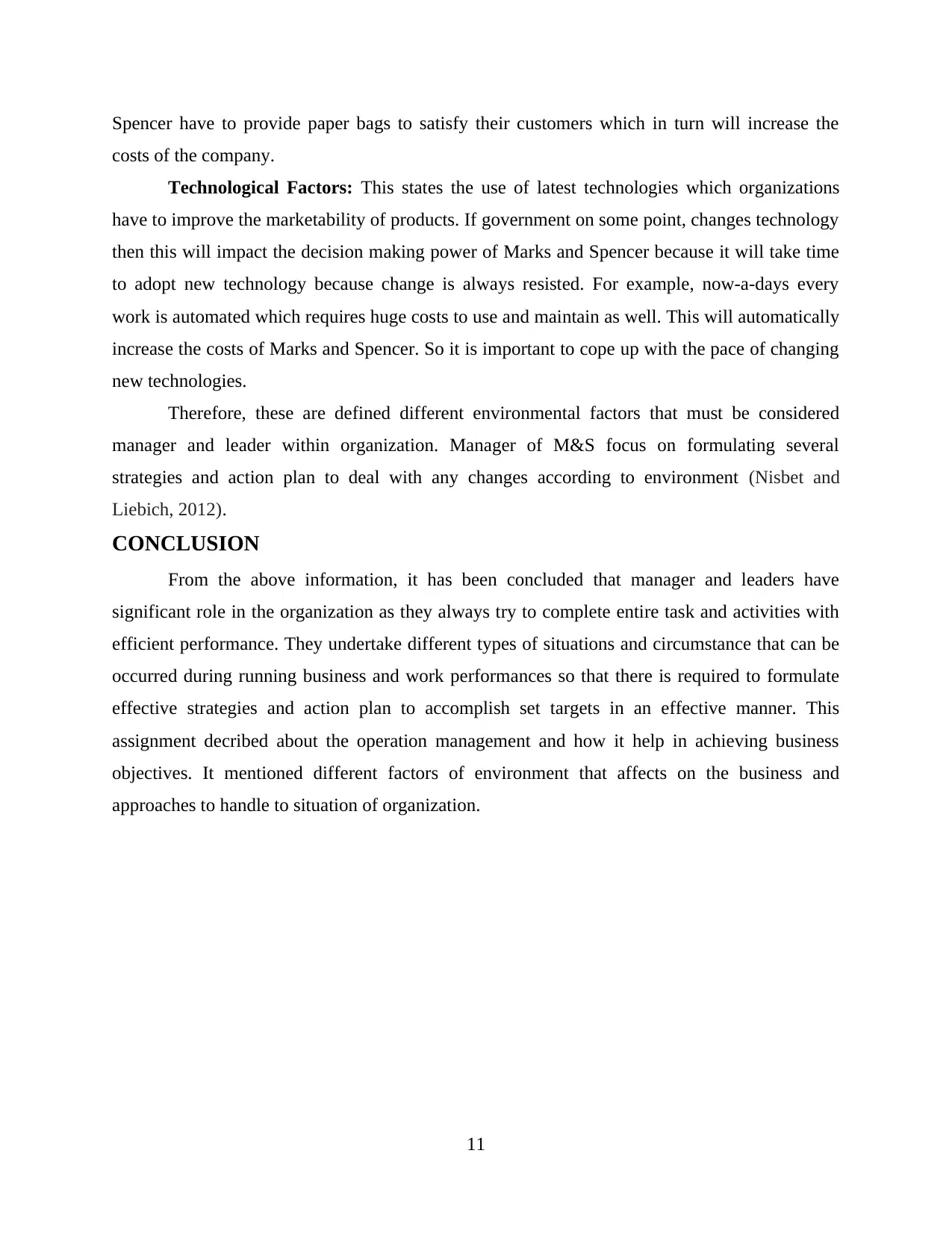
Spencer have to provide paper bags to satisfy their customers which in turn will increase the
costs of the company.
Technological Factors: This states the use of latest technologies which organizations
have to improve the marketability of products. If government on some point, changes technology
then this will impact the decision making power of Marks and Spencer because it will take time
to adopt new technology because change is always resisted. For example, now-a-days every
work is automated which requires huge costs to use and maintain as well. This will automatically
increase the costs of Marks and Spencer. So it is important to cope up with the pace of changing
new technologies.
Therefore, these are defined different environmental factors that must be considered
manager and leader within organization. Manager of M&S focus on formulating several
strategies and action plan to deal with any changes according to environment (Nisbet and
Liebich, 2012).
CONCLUSION
From the above information, it has been concluded that manager and leaders have
significant role in the organization as they always try to complete entire task and activities with
efficient performance. They undertake different types of situations and circumstance that can be
occurred during running business and work performances so that there is required to formulate
effective strategies and action plan to accomplish set targets in an effective manner. This
assignment decribed about the operation management and how it help in achieving business
objectives. It mentioned different factors of environment that affects on the business and
approaches to handle to situation of organization.
11
costs of the company.
Technological Factors: This states the use of latest technologies which organizations
have to improve the marketability of products. If government on some point, changes technology
then this will impact the decision making power of Marks and Spencer because it will take time
to adopt new technology because change is always resisted. For example, now-a-days every
work is automated which requires huge costs to use and maintain as well. This will automatically
increase the costs of Marks and Spencer. So it is important to cope up with the pace of changing
new technologies.
Therefore, these are defined different environmental factors that must be considered
manager and leader within organization. Manager of M&S focus on formulating several
strategies and action plan to deal with any changes according to environment (Nisbet and
Liebich, 2012).
CONCLUSION
From the above information, it has been concluded that manager and leaders have
significant role in the organization as they always try to complete entire task and activities with
efficient performance. They undertake different types of situations and circumstance that can be
occurred during running business and work performances so that there is required to formulate
effective strategies and action plan to accomplish set targets in an effective manner. This
assignment decribed about the operation management and how it help in achieving business
objectives. It mentioned different factors of environment that affects on the business and
approaches to handle to situation of organization.
11
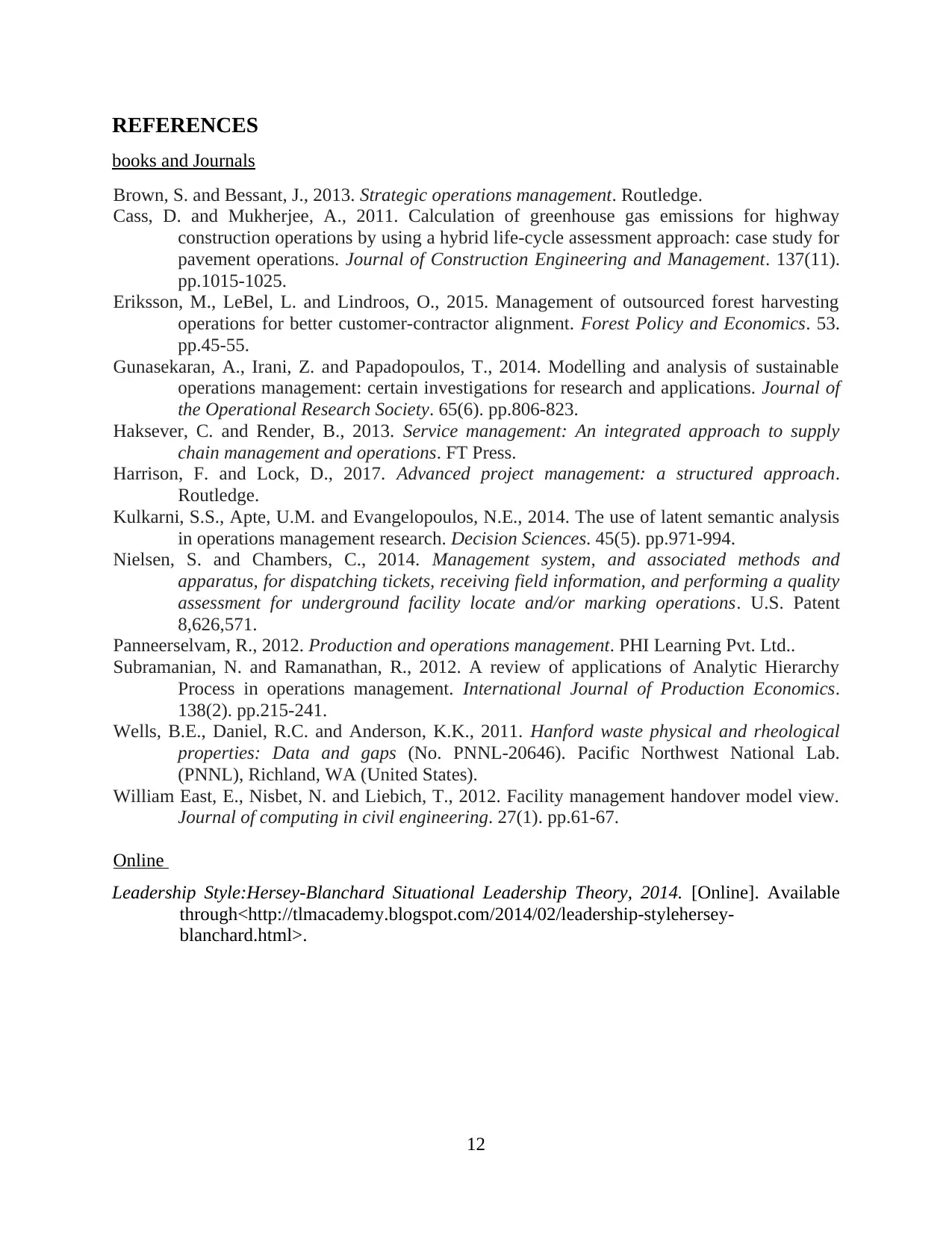
REFERENCES
books and Journals
Brown, S. and Bessant, J., 2013. Strategic operations management. Routledge.
Cass, D. and Mukherjee, A., 2011. Calculation of greenhouse gas emissions for highway
construction operations by using a hybrid life-cycle assessment approach: case study for
pavement operations. Journal of Construction Engineering and Management. 137(11).
pp.1015-1025.
Eriksson, M., LeBel, L. and Lindroos, O., 2015. Management of outsourced forest harvesting
operations for better customer-contractor alignment. Forest Policy and Economics. 53.
pp.45-55.
Gunasekaran, A., Irani, Z. and Papadopoulos, T., 2014. Modelling and analysis of sustainable
operations management: certain investigations for research and applications. Journal of
the Operational Research Society. 65(6). pp.806-823.
Haksever, C. and Render, B., 2013. Service management: An integrated approach to supply
chain management and operations. FT Press.
Harrison, F. and Lock, D., 2017. Advanced project management: a structured approach.
Routledge.
Kulkarni, S.S., Apte, U.M. and Evangelopoulos, N.E., 2014. The use of latent semantic analysis
in operations management research. Decision Sciences. 45(5). pp.971-994.
Nielsen, S. and Chambers, C., 2014. Management system, and associated methods and
apparatus, for dispatching tickets, receiving field information, and performing a quality
assessment for underground facility locate and/or marking operations. U.S. Patent
8,626,571.
Panneerselvam, R., 2012. Production and operations management. PHI Learning Pvt. Ltd..
Subramanian, N. and Ramanathan, R., 2012. A review of applications of Analytic Hierarchy
Process in operations management. International Journal of Production Economics.
138(2). pp.215-241.
Wells, B.E., Daniel, R.C. and Anderson, K.K., 2011. Hanford waste physical and rheological
properties: Data and gaps (No. PNNL-20646). Pacific Northwest National Lab.
(PNNL), Richland, WA (United States).
William East, E., Nisbet, N. and Liebich, T., 2012. Facility management handover model view.
Journal of computing in civil engineering. 27(1). pp.61-67.
Online
Leadership Style:Hersey-Blanchard Situational Leadership Theory, 2014. [Online]. Available
through<http://tlmacademy.blogspot.com/2014/02/leadership-stylehersey-
blanchard.html>.
12
books and Journals
Brown, S. and Bessant, J., 2013. Strategic operations management. Routledge.
Cass, D. and Mukherjee, A., 2011. Calculation of greenhouse gas emissions for highway
construction operations by using a hybrid life-cycle assessment approach: case study for
pavement operations. Journal of Construction Engineering and Management. 137(11).
pp.1015-1025.
Eriksson, M., LeBel, L. and Lindroos, O., 2015. Management of outsourced forest harvesting
operations for better customer-contractor alignment. Forest Policy and Economics. 53.
pp.45-55.
Gunasekaran, A., Irani, Z. and Papadopoulos, T., 2014. Modelling and analysis of sustainable
operations management: certain investigations for research and applications. Journal of
the Operational Research Society. 65(6). pp.806-823.
Haksever, C. and Render, B., 2013. Service management: An integrated approach to supply
chain management and operations. FT Press.
Harrison, F. and Lock, D., 2017. Advanced project management: a structured approach.
Routledge.
Kulkarni, S.S., Apte, U.M. and Evangelopoulos, N.E., 2014. The use of latent semantic analysis
in operations management research. Decision Sciences. 45(5). pp.971-994.
Nielsen, S. and Chambers, C., 2014. Management system, and associated methods and
apparatus, for dispatching tickets, receiving field information, and performing a quality
assessment for underground facility locate and/or marking operations. U.S. Patent
8,626,571.
Panneerselvam, R., 2012. Production and operations management. PHI Learning Pvt. Ltd..
Subramanian, N. and Ramanathan, R., 2012. A review of applications of Analytic Hierarchy
Process in operations management. International Journal of Production Economics.
138(2). pp.215-241.
Wells, B.E., Daniel, R.C. and Anderson, K.K., 2011. Hanford waste physical and rheological
properties: Data and gaps (No. PNNL-20646). Pacific Northwest National Lab.
(PNNL), Richland, WA (United States).
William East, E., Nisbet, N. and Liebich, T., 2012. Facility management handover model view.
Journal of computing in civil engineering. 27(1). pp.61-67.
Online
Leadership Style:Hersey-Blanchard Situational Leadership Theory, 2014. [Online]. Available
through<http://tlmacademy.blogspot.com/2014/02/leadership-stylehersey-
blanchard.html>.
12
⊘ This is a preview!⊘
Do you want full access?
Subscribe today to unlock all pages.

Trusted by 1+ million students worldwide
1 out of 15
Related Documents
Your All-in-One AI-Powered Toolkit for Academic Success.
+13062052269
info@desklib.com
Available 24*7 on WhatsApp / Email
![[object Object]](/_next/static/media/star-bottom.7253800d.svg)
Unlock your academic potential
© 2024 | Zucol Services PVT LTD | All rights reserved.





